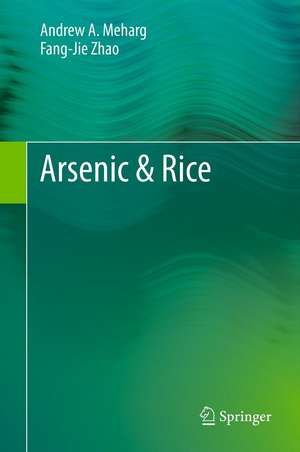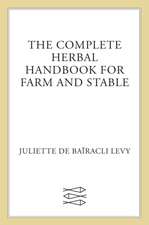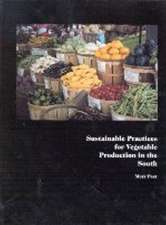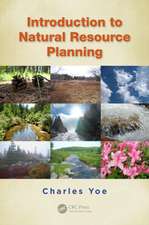Arsenic & Rice
Autor Andrew A. Meharg, Fang-Jie Zhaoen Limba Engleză Paperback – 16 apr 2014
| Toate formatele și edițiile | Preț | Express |
|---|---|---|
| Paperback (1) | 939.46 lei 6-8 săpt. | |
| SPRINGER NETHERLANDS – 16 apr 2014 | 939.46 lei 6-8 săpt. | |
| Hardback (1) | 943.07 lei 6-8 săpt. | |
| SPRINGER NETHERLANDS – mar 2012 | 943.07 lei 6-8 săpt. |
Preț: 939.46 lei
Preț vechi: 1145.68 lei
-18% Nou
Puncte Express: 1409
Preț estimativ în valută:
179.79€ • 187.01$ • 148.43£
179.79€ • 187.01$ • 148.43£
Carte tipărită la comandă
Livrare economică 15-29 aprilie
Preluare comenzi: 021 569.72.76
Specificații
ISBN-13: 9789400796553
ISBN-10: 9400796552
Pagini: 184
Ilustrații: XII, 172 p.
Dimensiuni: 155 x 235 x 10 mm
Greutate: 0.27 kg
Ediția:2012
Editura: SPRINGER NETHERLANDS
Colecția Springer
Locul publicării:Dordrecht, Netherlands
ISBN-10: 9400796552
Pagini: 184
Ilustrații: XII, 172 p.
Dimensiuni: 155 x 235 x 10 mm
Greutate: 0.27 kg
Ediția:2012
Editura: SPRINGER NETHERLANDS
Colecția Springer
Locul publicării:Dordrecht, Netherlands
Public țintă
GraduateCuprins
Acknowledgements.- Abbreviations.- Chapter 1: Introduction.- 1.1 Arsenic exposure from rice.- 1.2 Historical context.- 1.3 Biogeochemistry of paddy soils.- 1.4 Plant Physiology.- 1.5 Summary.-References.- Chapter 2: Arsenic in rice grain.- 2.1 Introduction.- 2.2 Quantification of arsenic in rice grain.- 2.3 Arsenic speciation in rice grain.- 2.4 Total grain arsenic.- 2.5 Rice products.- References.- Chapter 3: Risk from arsenic in rice grain.- 3.1 Rice consumption.- 3.2 Studies on the total intake of inorganic arsenic.- 3.3 Problems with ignoring rice when looking at dietary intake of arsenic.- 3.4 The effects of cooking rice on its arsenic content.- 3.5 Human bioavailability of arsenic in rice.- 3.6 Risk assessment from arsenic in rice.- 3.7 Food arsenic standards.- 3.8 Limiting arsenic exposure to rice.- References.- Chapter 4: Sources and losses of arsenic to paddy fields.- 4.1 Introduction.- 4.2 Sources of arsenic to paddy ecosystems.- 4.3 Paddy field arsenic cycling in a wider hydrological context.- References.- Chapter 5: Biogeochemistry of arsenic in paddy environments.- 5.1 Overview of the biogeochemistry of paddy soil.- 5.2 Arsenic transformations in paddy soil.- 5.3 Impact of groundwater irrigation on arsenic dynamics in paddy fields.- References.- Chapter 6: The physiology of arsenic in rice.- 6.1 Introduction.- 6.2 Mechanisms of arsenic uptake by roots.- 6.3 Transformation of arsenic species in plant.- 6.4 Arsenic sequestration in plant.- 6.5 Long-distance transport and unloading of arsenic to rice grain.- 6.6 Arsenic toxicity and straighthead disease.- References.- Chapter 7: Strategies for producing low arsenic rice.- 7.1 Introduction.- 7.2 Paddy field water management.- 7.3 Cultivar selection and breeding low arsenic rice.- 7.4 Fertilization and soil amendments.- References.- Chapter 8: Arsenic in other crops.- 8.1 Introduction.- 8.2 Wheat.- 8.3 Maize.- 8.4 Potato.- 8.5 Pulses.- 8.6 Vegetables.- 8.7 Fruits.- References.
Textul de pe ultima copertă
Rice is the staple food for half of the world’s population. Consumption of rice is the major exposure route globally to the class one, non-threshold carcinogen inorganic arsenic. This book explains the sources of arsenic to paddy soils and the biogeochemical processes and plant physiological attributes of paddy soil-rice ecosystems that lead to high concentrations of arsenic in rice grain. It presents the global pattern of arsenic concentration and speciation in rice, discusses human exposures to inorganic arsenic from rice and the resulting health risks. It also highlights particular populations that have the highest rice consumptions, which include Southern and South East Asians, weaning babies, gluten intolerance sufferers and those consuming rice milk. The book also presents the information of arsenic concentration and speciation in other major crops and outlines approaches for lowering arsenic in rice grain and in the human diet through agronomic management.
Caracteristici
The first book on arsenic and rice, written by the leading experts in this field Highlights an emerging major issue for human diets Integrates state-of-the-art biogeochemical and physiological understanding of the soil-plant continuum with respect to arsenic.






